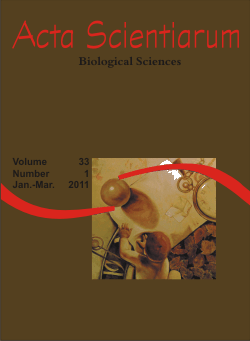<b>Mass balance of nutrients during the filling phase of two reservoirs of Sistema Produtor Alto Tietê (SPAT)</b> - doi: 10.4025/actascibiolsci.v33i1.7313
Keywords:
water supply, nitrogen, phosphorus
Abstract
Paraitinga and Biritiba reservoirs are part of Sistema Produtor Alto Tietê and they play an important role at the public water supply. The purpose of this study is to understand the mass balance of nitrogen and phosphorus that can influence the eutrophication process in reservoirs during the filling phase, and provide information for the implementation of mechanisms to manage water quality. Water samples were collected from August 2005 until May 2006. Concentrations of total phosphorus (PT) and total nitrogen (NT) were measured and the mass balance and loads were estimated. Paraitinga reservoir presented retention of NT and PT during the dry season and export during the rainy season; whilst at Biritiba reservoir we evidenced retention of NT and PT for both dry and rainy seasons. The annual balance demonstrated that during the reservoirs filling process, the systems retain NT and PT. The retention of nutrients into the system indicates that the environments have been modified leading to eutrophication and its consequences, and that it is necessary to outline strategies in order to mitigate the problem and suggest implementation of techniques to reduce the diffuse load.Downloads
Download data is not yet available.
Published
2011-02-08
How to Cite
Cope, V., Mercante, C. T. J., Carmo, C. F. do, Sendacz, S., & Monteiro Junior, A. J. (2011). <b>Mass balance of nutrients during the filling phase of two reservoirs of Sistema Produtor Alto Tietê (SPAT)</b> - doi: 10.4025/actascibiolsci.v33i1.7313. Acta Scientiarum. Biological Sciences, 33(1), 49-57. https://doi.org/10.4025/actascibiolsci.v33i1.7313
Issue
Section
Ecology and Limnology
DECLARATION OF ORIGINALITY AND COPYRIGHTS
I Declare that current article is original and has not been submitted for publication, in part or in whole, to any other national or international journal.
The copyrights belong exclusively to the authors. Published content is licensed under Creative Commons Attribution 4.0 (CC BY 4.0) guidelines, which allows sharing (copy and distribution of the material in any medium or format) and adaptation (remix, transform, and build upon the material) for any purpose, even commercially, under the terms of attribution.
Read this link for further information on how to use CC BY 4.0 properly.
0.6
2019CiteScore
31st percentile
Powered by 

0.6
2019CiteScore
31st percentile
Powered by 











1.png)




3.png)













